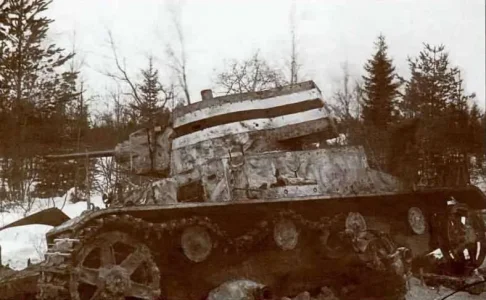Finnish soldier with a LS/26 light machine gun during the Winter War, Finland, February 1940.
In 1924 a regimental armorer, Aimo Lahti, who previously had submitted a prototype submachine gun for Finnish Army consideration, was assigned to the weapons department of the Finnish Ministry of Defence with the task of developing a light machine gun for the army. At about the same time, a special commission started a series of trials of foreign light machine gun designs, although the preference was to adopt a domestic design. Lahti, who partnered with Lieutenant Arvo Saloranta, submitted the first prototype of a light machine gun in July 1925. It was tested alongside foreign designs such as the Swiss Furrer Lmg 25, American Browning BAR M1918, British Vickers-Berthier and French Hotchkiss. After a year of trials, the domestic design was considered to be the best overall, and subsequently adopted as the “Pikakivääri m/26”, although it is most often referred to as the LS/26, after its inventors Lahti and Saloranta. Production of the new machine gun commenced in 1930 at the newly built government arms factory Valtion Kivääritehdas or VKT. Production of the LS/26 was relatively slow, mostly for the domestic market - there was only one significant export order that came in the mid-1930s from China for 30,000 guns in 7.92 Mauser. This was fulfilled only partially (about 1,200 guns produced and shipped to China) due to diplomatic pressure from Japan.
The weapon was able to fire in both full automatic and semi-automatic modes, and both 20-round box and 75-round drum magazines were produced, but the Finnish Army only used the smaller 20-round magazine. This may have been due to the extra weight and how cumbersome the drums may have been.
In the Winter War, there were two squads in each platoon that provided covering fire for two ten-man rifle squads. In each squad, there was one M/26 gunner, one assistant and the rest of the men carrying rifles. Soldiers found it would jam when magazine was loaded to capacity. Often they would take a round out of the magazine and hope an officer didn't inspect it. On the battlefield, the LS/26 was found to be heavy, hard to clean due to the 188 parts of the gun, and lacking in magazine capacity. It was nicknamed Kootut virheet, "assorted mistakes". On the other hand, proficient gunners liked and took full advantage of the exceptional accuracy of the weapon, and with oiling adapted for winter, it turned out to be very reliable. Due to the problems first encountered by Finnish troops, they often preferred the Degtyarev light machine gun when thousands of them were captured from the Soviets and used against their former owners. All in all, in the summer of 1944, only 3,400 M/26s were at the front, compared to over 9,000 Degtyarevs.













